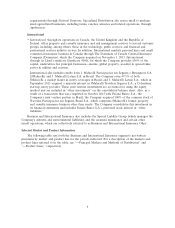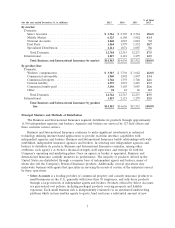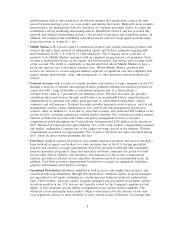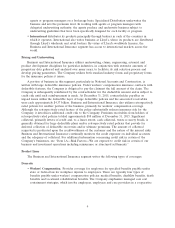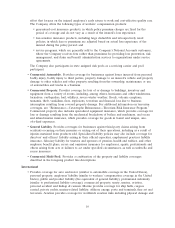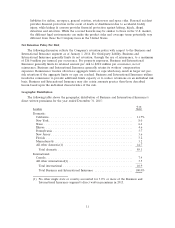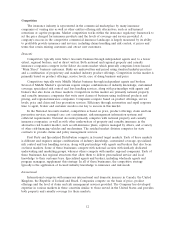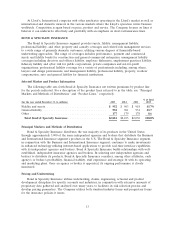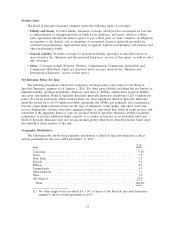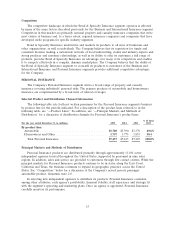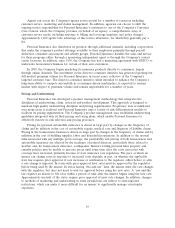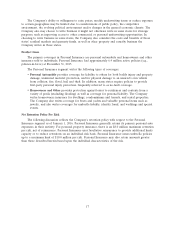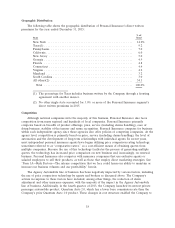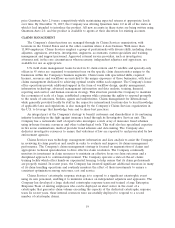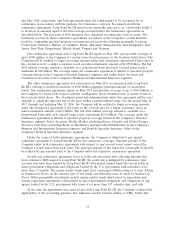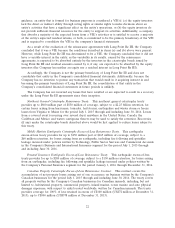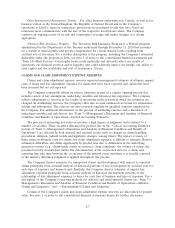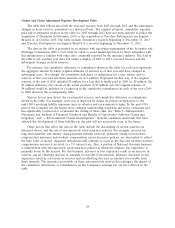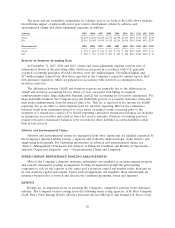Travelers 2015 Annual Report Download - page 16
Download and view the complete annual report
Please find page 16 of the 2015 Travelers annual report below. You can navigate through the pages in the report by either clicking on the pages listed below, or by using the keyword search tool below to find specific information within the annual report.Agents can access the Company’s agency service portal for a number of resources including
customer service, marketing and claims management. In addition, agencies can choose to shift the
ongoing service responsibility for Personal Insurance’s customers to one of the Company’s Customer
Care Centers, where the Company provides, on behalf of an agency, a comprehensive array of
customer service needs, including response to billing and coverage inquiries, and policy changes.
Approximately 1,400 agents take advantage of this service alternative, for which they generally pay a
fee.
Personal Insurance also distributes its products through additional channels, including corporations
that make the company’s product offerings available to their employees primarily through payroll
deduction, consumer associations and affinity groups. Personal Insurance handles the sales and service
for these programs either through a sponsoring independent agent or through the Company’s contact
center locations. In addition, since 1995, the Company has had a marketing agreement with GEICO to
underwrite homeowners business for certain of their auto customers.
In 2009, the Company began marketing its insurance products directly to consumers, largely
through online channels. The investment in the direct-to-consumer initiative has generated growing but
still modest premium volume for Personal Insurance in recent years, reflective of the Company’s
targeted customer base. The direct-to-consumer initiative, while intended to enhance the Company’s
long-term ability to compete successfully in a consumer-driven marketplace, is expected to remain
modest with respect to premium volume and remain unprofitable for a number of years.
Pricing and Underwriting
Personal Insurance has developed a product management methodology that integrates the
disciplines of underwriting, claim, actuarial and product development. This approach is designed to
maintain high quality underwriting discipline and pricing segmentation. Proprietary data accumulated
over many years is analyzed and Personal Insurance uses a variety of risk differentiation models to
facilitate its pricing segmentation. The Company’s product management area establishes underwriting
guidelines integrated with its filed pricing and rating plans, which enable Personal Insurance to
effectively execute its risk selection and pricing processes.
Pricing for personal automobile insurance is driven in large part by changes in the frequency of
claims and by inflation in the cost of automobile repairs, medical care and litigation of liability claims.
Pricing in the homeowners business is driven in large part by changes in the frequency of claims and by
inflation in the cost of building supplies, labor and household possessions. In addition to the normal
risks associated with any multiple peril coverage, the profitability and pricing of both homeowners and
automobile insurance are affected by the incidence of natural disasters, particularly those related to
weather and, for homeowners insurance, earthquakes. Insurers writing personal lines property and
casualty policies may be unable to increase prices until some time after the costs associated with
coverage have increased, primarily because of state insurance rate regulation. The pace at which an
insurer can change rates in response to increased costs depends, in part, on whether the applicable
state law requires prior approval of rate increases or notification to the regulator either before or after
a rate change is imposed. In states with prior approval laws, rates must be approved by the regulator
before being used by the insurer. In states having ‘‘file-and-use’’ laws, the insurer must file rate changes
with the regulator, but does not need to wait for approval before using the new rates. A ‘‘use-and-file’’
law requires an insurer to file rates within a period of time after the insurer begins using the new rate.
Approximately one-half of the states require prior approval of most rate changes. In addition, changes
to methods of marketing and underwriting in some jurisdictions are subject to state-imposed
restrictions, which can make it more difficult for an insurer to significantly manage catastrophe
exposures.
16


